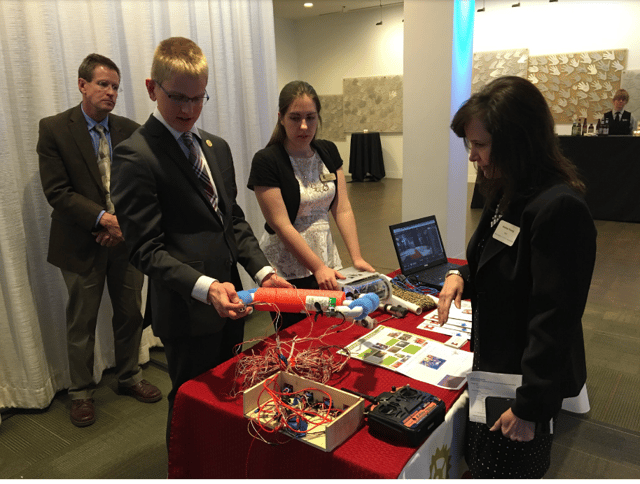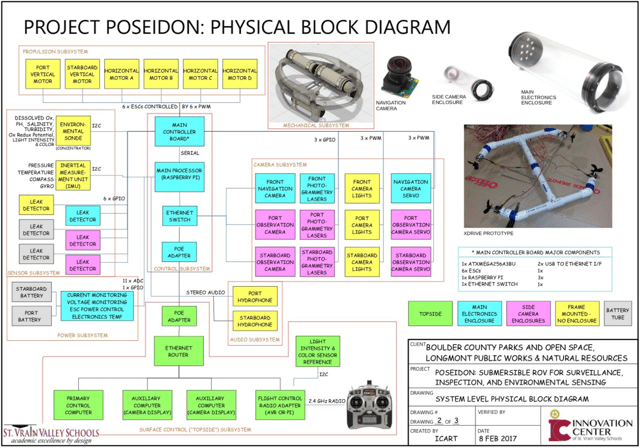A few weeks ago I got the chance to check out the St. Vrain Innovation Center’s demo night for their robotics teams at Galvanize Boulder (through the Boulder is for Robots Meetup). If you’re unfamiliar with either organization, both are awesome examples of some of the cool directions tech education is going. Galvanize refers to itself as a learning community. It has programs for web development and data science, along with a ton of resources for startups and entrepreneurs (seriously, check out their site). St. Vrain Innovation Center is a student program within the St. Vrain School District here in Colorado (SparkFun’s headquarters is in this district). It teaches tech skills to K–12 students through projects and courses. Also, coming soon is an incredible new building to house this program.

Demonstration of one of the projects at this year's CTA conference.
My intention was to quickly check out the projects, then duck out to dinner in Boulder (all the great dinner spots are near Galvanize). But the projects were so engaging, I stayed the whole time! Explaining the projects on their own would be interesting enough. The projects the kids are working on are excellent, practical solutions to an interesting subset of problems. They’re perfect examples of how the advancements in technology over the past five years are making a large (yet sometimes unseen) impact on our world.
In my position at SparkFun, I get to see innovations in technology all the time. As I get introduced to new sensors and other components, it becomes fairly clear the problems they can solve. Seeing these students put these sensors to the test is incredibly awesome to me. I rarely get to see these sensors functioning in the real world, so I wanted to hear all about what they were using them for.
The night included talks from the student leaders on each of their projects. Projects that include depth-plotting aquatic vehicles, micro-environmental monitoring drones and prehensile prosthetic limbs. The tasks the students are presented with in each project provide real-world skills they can use in their careers...mainly because they’re solving real-world, contemporary problems. The more standard, yet still incredible, programs like Vex Robotics were present as well and offered opportunities for the younger students. I’d really like to go on about the projects, what the students are learning, and what problems they are solving, but I don’t believe that to be the coolest part of what I witnessed at demo night. Don’t get me wrong; this stuff is really, REALLY cool. But even more cool is how the program is presenting this opportunity to students.

A block diagram of one of the aquatic projects, Project Poseidon.
Advancing Learning Opportunities
One of the points I often reiterate in relation to our education efforts is that we are providing learning opportunities that were not present when we were in school (I feel good about calling this more and more of a false statement as time goes on). The hardware, software and resources we have today simply were not available at that time. The resources and products that were around then were geared toward (and thought of as) higher education –- not a lot was going on at the K–12 level. What I got to see at this showcase was something amazing. The work didn’t seem to me like something coming out of an after-school program but rather a college-level design project. Rather than proof of concept praising the simple accomplishment (there is nothing wrong with that; I often praise my POC designs) their projects are representative of pragmatic designs of professional-level products. As so, the demo night included a discussion about how the students sometimes get paid for their work. That’s amazing! I could have never dreamed that design projects I worked on in high school could earn me a paycheck!
I got to learn a lot about what problems these students were trying to solve. Some were problems I didn’t realize existed until after the demonstration. Others had solutions that made a lot more sense by the end of the presentation. The solutions the students were working on were great examples of how robotics can help solve problems from an automation standpoint and also problems that wouldn’t make sense to address with manual labor.
I encourage you to read up on both organizations involved in this event. As I understand, the St. Vrain Innovation Center is always in need of mentors, so if you have skills that could be beneficial to this group and their students, drop them an email.


Events, student projects, robotics, STEM